13 Famous Cave Paintings (With a Brief History) in 2025
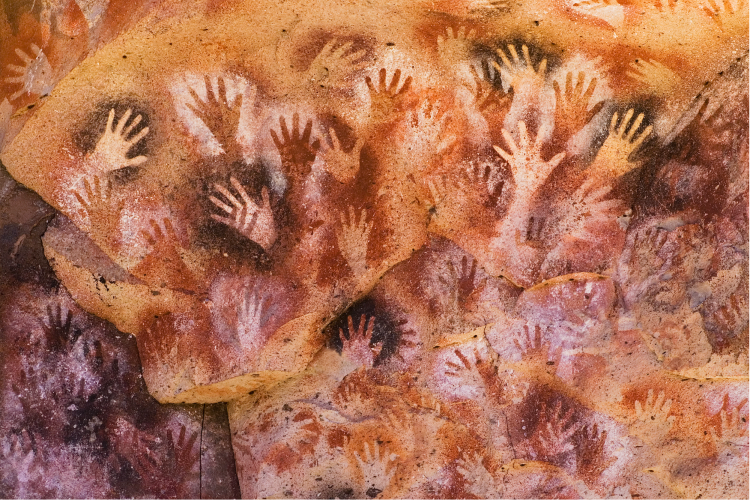
Cave paintings are an exciting look into the minds of Stone Age humans and archaic humans. While we may not want to learn to paint from the paintings of these Stone Age primates, we can still learn a lot about what early life was like from these works of art.
Discover the history of these ancient paintings and the most famous cave paintings discovered to date. Think of all the fascinating cave paintings just waiting to be unearthed!
Jump to Section
Cave Paintings History
What Is the Paleolithic Period?

The Paleolithic Period, also known as the Old Stone Age, marks a significant stage in human technological and cultural development. This era (roughly 2.5 million years ago to 10,000 B.C.) is defined by the creation and use of rudimentary chipped stone tools, which played a crucial role in early survival and craftsmanship. These tools included pebble tools — rocks shaped by striking them with another stone to create serrated edges used for chopping— and hand adzes, which featured a single-bevel cutting edge. Early humans also crafted stone scrapers, cleavers and points for various purposes.
In addition to stone, materials such as bone and wood were used to fashion tools. Artistic expression flourished during this period, with small sculptures like carved stone statuettes of women, clay animal figurines and intricate bone and ivory carvings. The era is also notable for its incised designs, reliefs and cave paintings, providing a glimpse into the early creativity of humankind.
Who Created Cave Paintings?
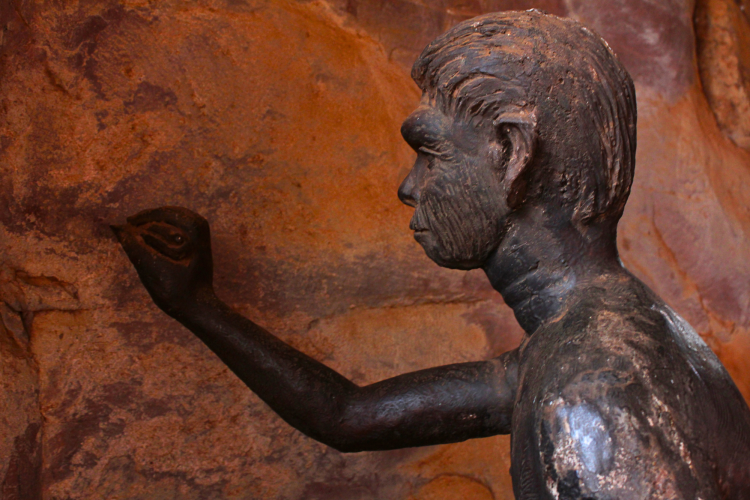
The oldest known cave paintings were actually made by Neanderthals (Homo neanderthalensis), a species closely related to modern humans. This discovery challenges the assumption that art was exclusive to Homo sapiens, showing that Neanderthals also engaged in creative expression. According to Smithsonian Magazine, the oldest cave painting discovered is “the world’s very first picture.” In fact, the oldest cave painting discovered to date is at least 51,200 years old.” It was likely made by Neanderthals.
Other excavated objects predate these cave paintings, sparking debate over whether they were intentionally crafted or shaped by natural forces. For example, fossil sponges from 62,000 years ago, found with holes through them, may have been strung together by early human species like Homo erectus and Homo heidelbergensis, possibly as primitive beads. If true, this would mark an early attempt at ornamentation and body decoration.
Similarly, the Tan-Tan figurine from Morocco and the Berekhat Ram figurine from Israel — both dating back over 20,000 years — raise questions about early human creativity. These objects may represent simplified human figures, though some argue their shapes could have formed naturally. If crafted intentionally, they suggest that earlier human species had advanced cognitive abilities and a sense of aesthetics.
Painting techniques and paint mediums for the ancients sound pretty cool!
What Do Cave Paintings Express?
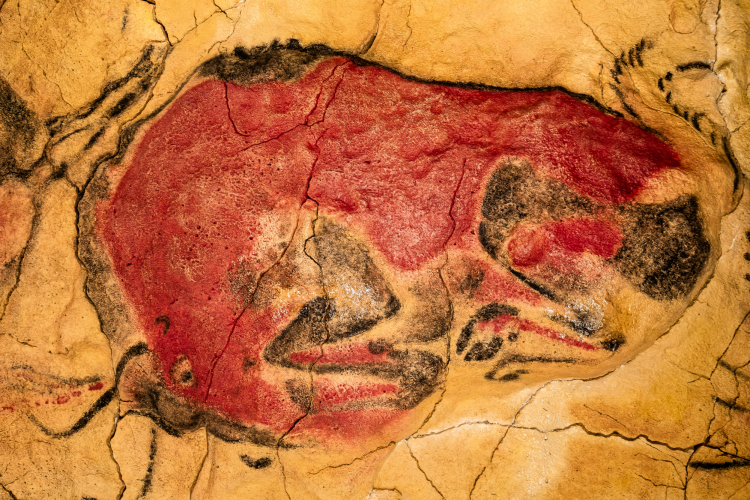
So, what was the purpose of cave paintings? Cave paintings in the Stone Age serve as a window into the minds and lives of early humans, offering clues about their environment, beliefs and daily activities. These artworks likely had multiple purposes, ranging from ritualistic to educational. They may have been used to communicate stories or document hunting practices or express spiritual or religious beliefs. Cave paintings were methods of communication! The detailed depictions of animals, for instance, could suggest a deep connection to nature, possibly reflecting the importance of wildlife in their survival and cultural identity.
You may be wondering, what is the most famous cave painting? One of the most famous cave paintings is found in the Lascaux Cave in France, dating back around 17,000 years. This site features intricate images of bulls, horses and deer, rendered in vibrant colors and remarkable detail. The sheer complexity of the artwork points to the possibility that cave paintings were also a form of artistic expression, showcasing early humans’ creativity and developing cognitive abilities.
What Are The 5 Types of Cave Art?
Cave art comes in a variety of styles and techniques. Here are the five main types of cave painting communication.
1. Petroglyphs

Petroglyphs are carvings or engravings created by chipping away at the rock surface to form images. This type of art typically depicts animals, abstract patterns and human figures and is often found on cave walls or rock faces.
2. Pictographs

Pictographs are paintings or drawings made on cave walls, created using natural pigments like charcoal, ochre and hematite. These images commonly feature animals, handprints and symbols, often using red, black or yellow pigments. These are often the classic images that come to mind when you think of cave paintings, and they’re much more basic than your watercolor painting for beginners classes.
3. Hand Stencils

One of the simplest forms of cave art, hand stencils are created by blowing pigment over a hand pressed against the cave wall, leaving a negative space in the shape of the hand. These are among the most iconic and recognizable types of cave art.
4. Engravings
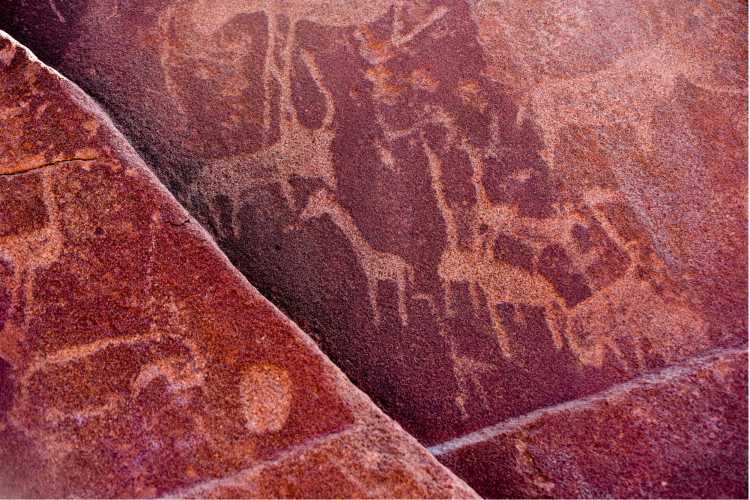
Engravings are etched into the rock using sharp tools or stones. This method often highlights details of animals, humans or symbols by deeply scoring the surface, providing a more lasting and prominent visual effect.
5. Reliefs
Relief art involves sculpting or carving the rock surface to create three-dimensional images. This type of cave art is less common but offers a more tactile and elaborate form of representation, usually focusing on animals or natural elements.
These diverse forms of cave art reflect early humans' creativity, communication and symbolic thinking, offering a glimpse into their lives and cultural practices. Discover a new form of self exprrssion with a modern online painting class!
Most Famous Prehistoric Cave Paintings
1. The Altamira Cave Paintings (Spain)
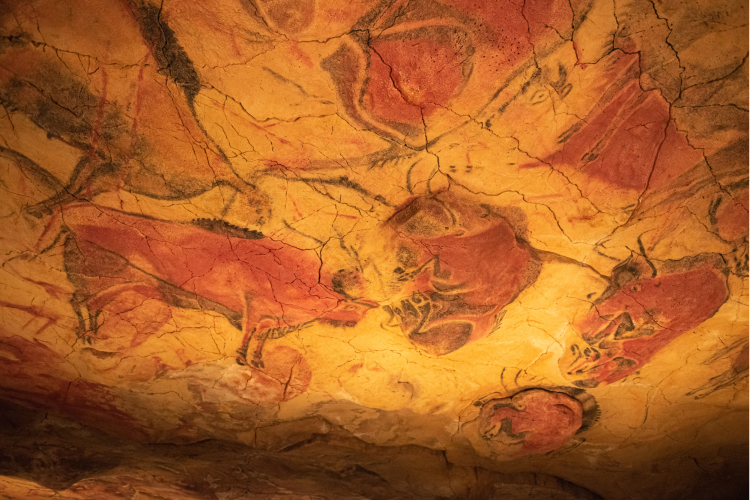
So, where are the cave paintings in Spain? Well, the Altamira Cave, located in northern Spain, is definitely the most famous Spanish cave painting. It’s adored for its stunning Upper Paleolithic paintings. These vivid images, dating back approximately 36,000 years, feature bison, horses, deer and human handprints, primarily painted in red, yellow and brown ochre. The cave's exceptional quality and artistic detail led to its nickname, the "Sistine Chapel of Prehistoric Art." Discovered in 1868 by a local hunter, Modesto Cubillas, it wasn't until 1879 that amateur archaeologist Marcelino Sanz de Sautuola and his daughter María unearthed the extraordinary paintings, sparking initial skepticism about their authenticity. Later research confirmed that the Altamira Cave represented one of the most significant early examples of human artistic expression.
The cave paintings reflect a sophisticated understanding of perspective and movement, using the cave's natural contours to give a three-dimensional effect to the animals. Many believe that these images were part of spiritual rituals or hunting magic, created to influence the abundance of game. The discovery of Altamira shifted the understanding of prehistoric art, providing evidence of the cognitive and creative abilities of early Homo sapiens. Altamira remains a UNESCO World Heritage Site, although access is now highly restricted to preserve the delicate artworks.
2. Lascaux (France)

Lascaux, located in the Dordogne region of southwestern France, is home to one of the most famous and intricate collections of Paleolithic cave paintings in the world. The cave was discovered in 1940 by four teenagers — Marcel Ravidat, Jacques Marsal, Georges Agnel and Simon Coencas —when their dog fell into a hidden entrance. The site quickly gained recognition for its over 600 painted and engraved images, mostly depicting animals such as horses, deer, bison and bulls, dating back around 17,000 years. These cave paintings are possibly related to hunting rituals. The most iconic part of the cave, known as the "Hall of the Bulls," features stunningly detailed depictions of large, dynamic animals rendered in vivid shades of red, yellow, black and brown. It’s otherworldly.
The artistry demonstrates a high level of sophistication in early humans, with complex use of perspective and shading techniques to convey motion and volume that could have seemed near magical at the time. Due to environmental concerns, the original cave was closed to the public in 1963, but a replica, Lascaux II, was created nearby, allowing visitors to experience the magnificence of this prehistoric treasure. Since then, a number of Lascaux replicas have been made. Lascaux is a UNESCO World Heritage Site, emblematic of the rich legacy of prehistoric art in France.
3. The Apollo 11 Cave Stones (Namibia)

The Apollo 11 Cave Stones are among the oldest known examples of African prehistoric art, dating back over 25,000 years. Discovered in 1969 by German archaeologist W.E. Wendt in the Huns Mountains of southern Namibia, the site was named after the Apollo 11 moon landing, which occurred around the same time. The cave's small stone slabs feature animal depictions, including a therianthropic figure — an animal with human-like characteristics. These cave paintings are rendered in charcoal, ochre and white pigment, revealing the early symbolic thinking of hunter-gatherer societies in Africa.
The significance of the Apollo 11 Cave lies in its age and the insight it provides into the cognitive development of early humans in southern Africa. The stone slabs are considered some of the earliest examples of portable art, suggesting that prehistoric communities not only decorated their living spaces but also carried symbolic objects with them. The discovery of these cave paintings has contributed to a broader understanding of the origins of artistic expression on the African continent.
4. Kakadu National Park and Other Rock Art Sites (Australia)

Spanning over 20,000 years, the cave paintings here offer a comprehensive view of Aboriginal culture, depicting everything from animals and hunting scenes to Dreamtime spiritual figures. Kakadu National Park, located in the Northern Territory of Australia, is a must-see. One of the most famous sites within Kakadu is Ubirr, where large rock shelters contain vivid representations of fish, turtles and kangaroos, painted in ochre, white and black. These artworks are continuously maintained by local Indigenous communities, preserving a living tradition.
The cave paintings in Kakadu are more than just a record of daily life; they serve a deep spiritual purpose, reflecting Aboriginal beliefs about the creation of the world and their connection to the land. In addition to Kakadu, other notable Australian rock art sites include Arnhem Land, where the famous "X-ray" style of depicting animals’ internal organs is found, and the Kimberley region, known for its ancient Wandjina figures.
Collectively, these sites showcase the deep, enduring bond between Aboriginal Australians and their environment, emphasizing the role of art in maintaining cultural identity and transmitting knowledge through generations.
5. The Lower Pecos Rock Art (Texas and Mexico)

The Lower Pecos Rock Art, located along the Pecos River in Texas and northern Mexico, is a significant archaeological site, featuring some of the oldest and most elaborate rock paintings in North America. Dating back over 4,000 years, these vibrant murals often depict human figures, animals and abstract symbols in a highly stylized manner, painted in red, yellow, white and black pigments. The artwork spans several caves and rock shelters, with the most famous sites being Panther Cave, Fate Bell Shelter and White Shaman.
The art is believed to have been created by hunter-gatherer societies who used these images as part of their spiritual and ceremonial practices. Many researchers suggest that the paintings represent shamanic rituals. We will never know exactly what they represent but the designs and recurring motifs provide valuable insights into the beliefs and environment of these ancient cultures. Despite their significance, these cave paintings are at risk of fading due to natural erosion, prompting ongoing conservation efforts to preserve this cultural heritage.
6. Cueva de las Manos (Argentina)

This cave, situated along the Pinturas River, was first discovered in 1941, though it had long been known to local communities. Cueva de las Manos, or "Cave of the Hands," is famous for its hundreds of stenciled handprints, dating back between 9,000 and 13,000 years. The handprints, mostly left hands, are thought to have been created by blowing pigment through hollow bones, leaving a negative space around the hands pressed against the cave wall. In addition to the hands, the cave features depictions of animals, hunting scenes and geometric shapes, all painted in red, white, black and yellow pigments.
These cave paintings are believed to have been made by the ancestors of the Tehuelche people, nomadic hunter-gatherers who inhabited the region. The images likely served a ritualistic or symbolic purpose, possibly related to hunting magic or social identity. Cueva de las Manos is now a UNESCO World Heritage Site, recognized for its exceptional preservation and insight into the lives of early humans in South America. The striking visuals of the hand stencils make it one of the most iconic examples of prehistoric art worldwide.
7. Sulawesi and Borneo (Indonesia)

The islands of Sulawesi and Borneo in Indonesia are home to some of the world's oldest known cave paintings, with images dating back at least 40,000 years. In Sulawesi, the most famous discovery is a hand stencil found in the Maros-Pangkep caves, alongside depictions of animals like pigs and anoa (a type of buffalo). These hand stencils, similar to those found in Argentina's Cueva de las Manos, were made by blowing red ochre pigment around a hand pressed against the cave wall. The paintings in Sulawesi have been linked to early Homo sapiens and demonstrate the spread of art across the world as human populations migrated out of Africa.
In Borneo, more recent discoveries revealed paintings of animals and abstract shapes, with some images dating back 40,000 to 52,000 years. The artwork predominantly features orangutans and local wild cattle, as well as handprints. These ancient cave paintings suggest a sophisticated understanding of the surrounding environment and a symbiotic relationship between early humans and wildlife.
The findings in Sulawesi and Borneo are considered some of the oldest examples of figurative art in the world, reshaping our understanding of prehistoric art and its geographic origins.
8. The Magura Cave (Bulgaria)

The Magura Cave in Bulgaria, located near the town of Rabisha, contains one of the most important collections of prehistoric cave paintings in Europe. The artwork dates back to the Late Neolithic, Chalcolithic and early Bronze Age periods, approximately 7,000 to 4,000 years ago. These paintings were created using bat guano (feces) as a pigment, resulting in striking black depictions of human figures, animals, abstract shapes and symbols. Among the most notable images are hunting scenes, dances and what appears to be a solar calendar, hinting at early attempts to track time and seasons.
The cave paintings in Magura likely had both ritualistic and symbolic purposes, with many of the figures resembling fertility or hunting scenes. The presence of a solar calendar suggests that the early inhabitants of the region had a growing understanding of astronomy and the changing seasons. The cave was discovered by locals, though scientific interest grew in the 20th century, leading to further exploration and documentation of the site. Today, Magura Cave is a UNESCO site and popular tourist destination, offering a glimpse into the lives and beliefs of ancient European communities.
9. Bhimbetka (India)

Bhimbetka is one of the more famous cave paintings in India. The Bhimbetka rock shelters house some of the oldest and most extensive prehistoric art in South Asia, dating back over 30,000 years. Discovered in 1957 by archaeologist V.S. Wakankar, the site consists of over 750 caves and rock shelters, many of which feature cave paintings that depict animals, hunting scenes and geometric patterns. The cave paintings span several millennia, from the Paleolithic to the Mesolithic and historic periods, showing an ongoing tradition of art over thousands of years.
The vivid depictions of bison, tigers and elephants, often painted in red and white ochre, reflect the early inhabitants' close relationship with their natural environment. Many of the paintings also include human figures engaged in dancing and communal activities, suggesting that these shelters may have served as social functions. Bhimbetka is a UNESCO World Heritage Site and is one of the cave paintings in India that serves as a key location for understanding the cultural and artistic evolution of early humans in the Indian subcontinent.
10. Serra da Capivara (Brazil)

Serra da Capivara National Park, located in northeastern Brazil, is home to some of the most significant prehistoric art in the Americas. The rock art found here dates back over 25,000 years, with hundreds of cave sites featuring painted images of animals, human figures and abstract symbols. Discovered by Brazilian archaeologist Niède Guidon in the 1970s, the site has revolutionized the understanding of human occupation in South America, suggesting that early humans may have settled the region much earlier than previously thought.
The cave paintings at Serra da Capivara often depict scenes of daily life, including hunting, dancing and communal gatherings, as well as animals like deer, felines and birds. The art is typically painted in red ochre, though other pigments were also used. Though, you may not want to learn how to make brown paint from the ancient artists. Today, Serra da Capivara is a UNESCO World Heritage Site and a vital part of Brazil's cultural heritage, attracting archaeologists and tourists alike.
11. Laas Gaal (Somalia)

These cave paintings, estimated to be around 5,000 to 11,000 years old, depict vividly colored images of cattle, humans and various geometric shapes. Laas Gaal is located in northern Somalia near the city of Hargeisa and is one of the most important prehistoric rock art sites in Africa. The artwork, created using natural pigments, is remarkably well-preserved due to the dry climate of the region. The depictions of cattle are particularly detailed, reflecting the importance of livestock in the lives of the region's ancient pastoral communities.
The site was first brought to international attention in 2002 by a French archaeological team, although it had been known to local inhabitants for much longer. The cave paintings at Laas Gaal are significant not only for their artistic merit but also for their insights into the early cultures of the Horn of Africa. The rock shelters are thought to have been used for religious or ceremonial purposes, possibly linked to a cattle cult or other forms of ancestor worship. In modern times, Laas Gaal is considered one of the most important archaeological sites in the Horn of Africa, providing a rare glimpse into the region's prehistoric past.
12. Tadrart Acacus (Libya)

The Tadrart Acacus mountain range, located in the Libyan desert, is home to a vast collection of prehistoric rock art, dating back between 12,000 and 8,000 years. The cave paintings and engravings found in the caves and rock shelters of this UNESCO World Heritage Site depict a wide variety of scenes, including animals such as giraffes, elephants and cattle, as well as human figures engaged in activities like hunting and dancing. The art reflects the dramatic environmental changes that occurred in the Sahara over millennia, transitioning from a lush, fertile region to the arid desert it is today.
Discovered in the 1930s by Italian archaeologist Fabrizio Mori, the rock art of Tadrart Acacus offers valuable insights into the lives of early Saharan societies, showing their interactions with the environment and each other. The detailed depictions of animals suggest a time when the Sahara supported a rich diversity of wildlife, while the images of human activities reveal the social and spiritual practices of ancient desert dwellers. Despite its significance, the site is under threat from environmental damage and political instability in the region.
13. Chauvet Cave (France)

Chauvet Cave, located in the Ardèche region of southern France, is one of the most remarkable and well-preserved examples of prehistoric art in the world. Discovered in 1994 by a group of speleologists (people who explore caves) led by Jean-Marie Chauvet, the cave contains more than 1,000 images, including cave paintings and engravings that date back approximately 32,000 years. The artwork predominantly features animals, such as horses, lions, rhinoceroses and mammoths, rendered in striking detail with techniques that include shading and perspective, showcasing the advanced artistic abilities of early humans.
What sets Chauvet apart from other cave art sites is the quality and variety of the images, as well as the clear evidence of symbolic thinking and narrative structure in the scenes. The cave paintings are believed to have been created by early Homo sapiens and likely served a ceremonial or spiritual purpose. Chauvet Cave is a UNESCO World Heritage Site, and access is strictly limited to preserve the fragile environment within. However, a replica of the cave, known as the Chauvet-Pont-d'Arc Cave, was opened to the public in 2015, allowing visitors to experience the awe-inspiring art without damaging the original site.
These famous cave paintings offer a glimpse into Stone Age life and culture. They’re a fascinating way to imagine prehistoric life and connect with those who came before.
For even more fun art gift ideas, check out other experiences happening on Classpop!

